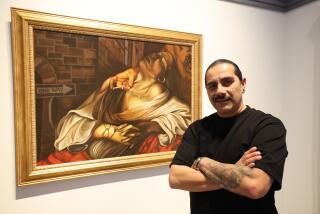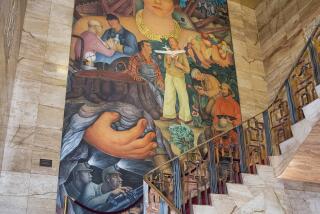Goya’s ‘Don Pedro, Duque de Osuna’ holds court at the Norton Simon
The Duque’s in town, and he looks fabulous.
As painted by Spanish master Francisco de Goya y Lucientes (1746-1828), the portrait, “Don Pedro, Duque de Osuna,” is on loan to the Norton Simon Museum from the Frick Collection in New York. Part of a biennial exchange program, it is on view through March 3.
Dating from the mid-1790s, “Don Pedro” was painted while Goya’s star was rising in the court of Spain’s King Charles IV. (He was appointed first court painter in 1799.) Among Goya’s most important patrons, the Duque and his wife, Countess Maria Josefa Pimentel, were great supporters of the arts. They commissioned almost 30 paintings from Goya over 15 years.
PHOTOS: Arts and culture in pictures by The Times
The affection, it seems, was mutual. Goya’s portrait of Don Pedro is surprisingly intimate. Seen in three-quarter view, the Duque stands against a plain, blue-black background, devoid of the usually courtly trappings of wealth or distinction. His body forms a triangle that presses resolutely upward: a man at the height of his powers. This formidable profile is anchored by his hands. One clutches the top of a walking stick; the other holds a piece of paper inscribed with his name and Goya’s, as if they were pen pals.
More striking is the painting’s liveliness and emotion. Don Pedro’s cheeks are rosy and his lips are slightly parted. His warm, black eyes gaze to the right, as if greeting a friend. With the light glinting off his creamy white jabot and silken coat, the portrait fairly glows.
Goya is renowned for his ability to render complex textures, a skill on view in one of the four Norton Simon Goyas the museum has brought out to keep the Duque company. In the portrait “Doña Francisca Vicenta Chollet y Caballero” from 1806, Goya renders delicate embroidery, a jeweled tiara and an ornate, feathered dog collar with masterful aplomb. But the flat lighting and the sitter’s stiff pose and expression contrast sharply with the warm treatment accorded the Duque.
Also on view is a selection of Goya’s prints from the Norton Simon’s extensive collection, including “The Sleep of Reason Produces Monsters” and “The Disasters of War.” Mostly created after “Don Pedro,” they attest to Goya’s eventual turn to darker subject matter. Combined with the loan from the Frick, it’s an opportunity to see the extremes of both joy and despair from the painter often dubbed “the last Old Master.”
More to Read
The biggest entertainment stories
Get our big stories about Hollywood, film, television, music, arts, culture and more right in your inbox as soon as they publish.
You may occasionally receive promotional content from the Los Angeles Times.






